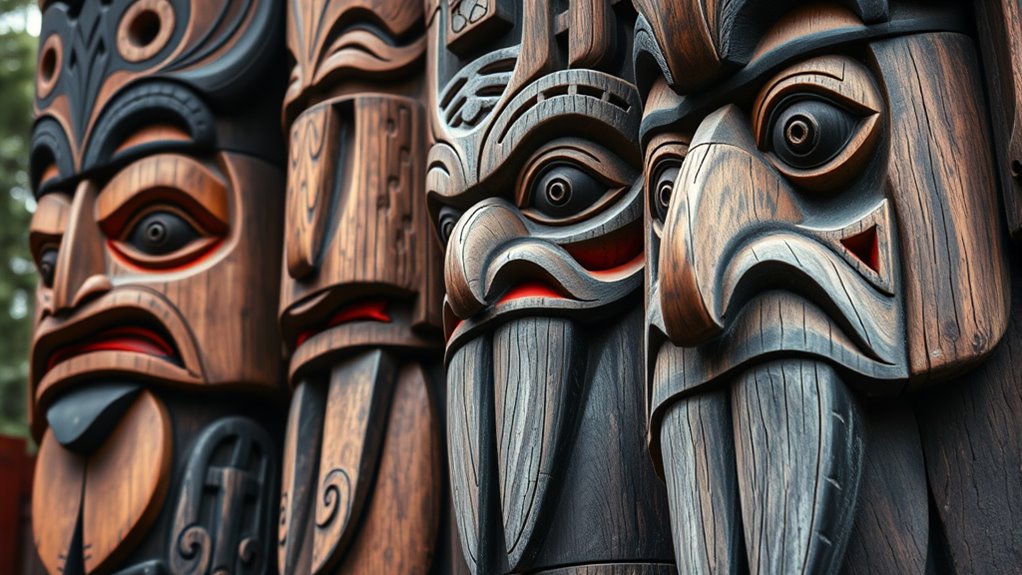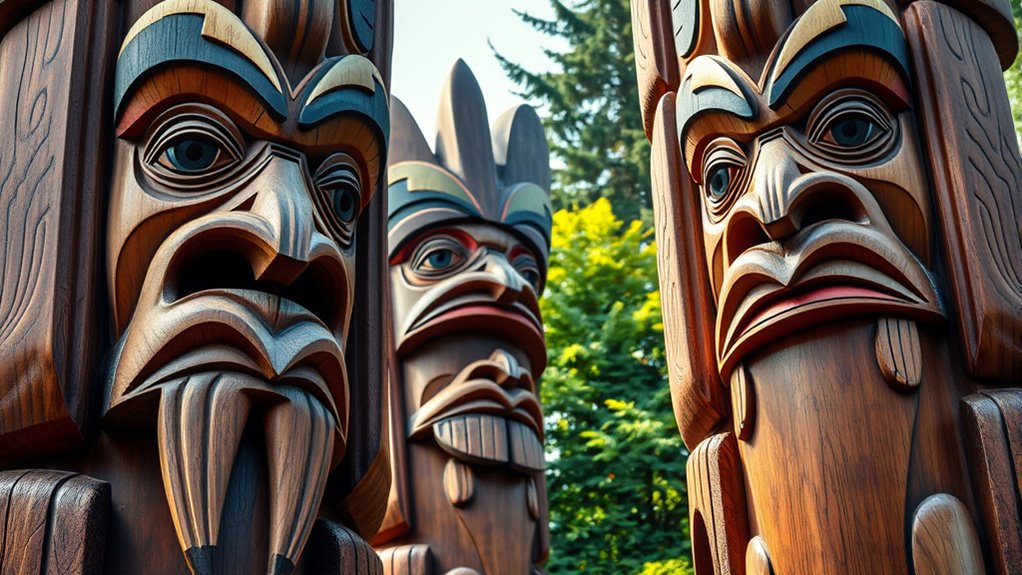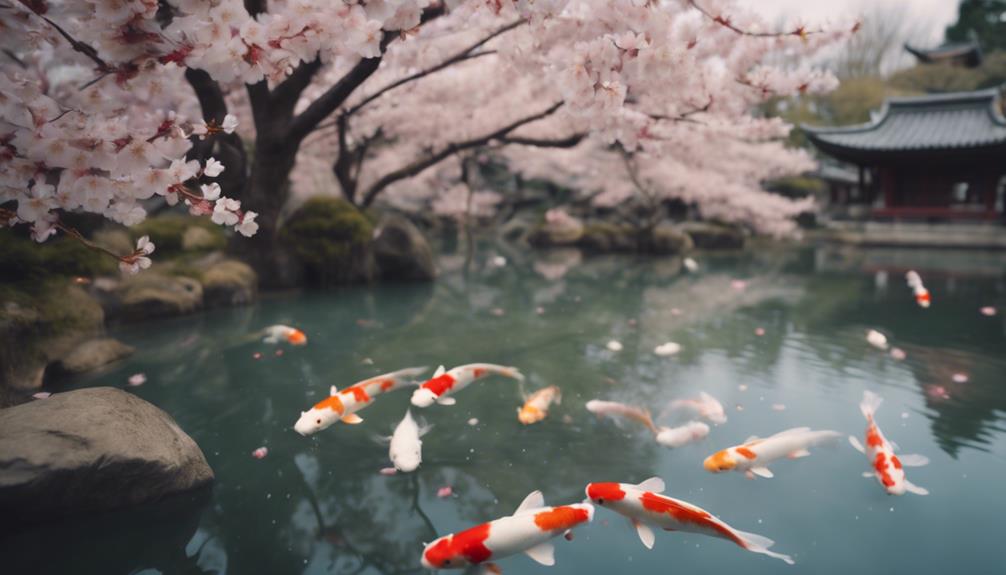Totem poles are like storybooks carved into durable cedar wood, showcasing the rich history and beliefs of indigenous communities. Each figure on a pole symbolizes animals, spirits, or mythological beings that convey stories about ancestors, social roles, and spiritual values. Creating a totem pole is a sacred act involving skilled craftsmanship and cultural rituals passed down through generations. If you keep exploring, you’ll discover how these remarkable carvings serve as powerful cultural monuments and storytelling symbols.
Key Takeaways
- Totem poles serve as visual storytellers, depicting community history, legends, and spiritual beliefs through intricate carvings.
- Crafted from durable cedar wood, these poles are meticulously carved by skilled artisans following cultural traditions.
- Each figure on a totem pole symbolizes animals, spirits, or mythological beings, conveying messages about identity and values.
- Carving is a sacred practice connecting artisans to ancestors, with spiritual rituals integral to the process.
- Totem poles act as cultural monuments, preserving indigenous heritage and engaging viewers in stories and cultural identity.

Have you ever wondered what stories and traditions are told through the striking carvings of totem poles? These towering artworks are more than just impressive structures; they serve as vibrant storytellers of indigenous communities’ histories and beliefs. Each totem pole is a masterpiece of indigenous craftsmanship, meticulously carved from cedar wood, a material valued for its durability and workability. As you observe these poles, you’re witnessing the skillful handiwork passed down through generations, reflecting centuries of tradition and expertise. The craftsmanship isn’t just about creating something beautiful—it’s a form of cultural expression that honors ancestors, legends, and social status within the community.
Totem poles are crafted from cedar wood, a durable and workable material, passing down indigenous craftsmanship and cultural stories through generations.
When you look at a totem pole, you’re also uncovering a rich language of cultural symbolism. Every figure carved into the wood has meaning, representing animals, spirits, or mythological beings that hold significance for the tribe. These symbols act as visual stories, conveying messages about lineage, achievements, or spiritual beliefs. For example, a towering bear might symbolize strength and protection, while an eagle could represent vision and freedom. The arrangement and choice of figures tell a narrative that’s unique to each community, serving as a bridge between the physical and spiritual worlds. Through these carvings, indigenous peoples communicate their identity, history, and values, preserving their cultural heritage in a tangible form.
As you stand before a totem pole, you might notice the intricate details and precision of each carving. This isn’t a task taken lightly; it’s a sacred act rooted in cultural tradition. Carvers spend years mastering their craft, often learning through apprenticeships that emphasize respect for the symbols and stories they create. The process involves more than just skill—it’s a spiritual practice that connects the carver to their ancestors and community. The totem pole becomes a living *testament* to indigenous craftsmanship, showcasing their artistic talent and cultural symbolism in every groove and figure. It’s a visual language that speaks across generations, allowing stories to be shared long after the carver’s hands have laid down their tools. Additionally, sustainable materials are often prioritized to ensure environmental harmony and longevity of these cultural monuments.
In essence, totem poles aren’t just wooden sculptures; they are storytelling monuments crafted with indigenous craftsmanship and layered with cultural symbolism. They invite you to explore the deep history and spiritual worldview of the communities that create them. When you stand before one, you’re not just observing art—you’re engaging with a living tradition that holds the stories, beliefs, and identities of a people. These poles remind us that storytelling isn’t only spoken or written; it’s carved in wood, carved in culture, and carved into history.
Frequently Asked Questions
How Do Totem Poles Influence Modern Indigenous Communities?
You see, the influence of totem poles on modern indigenous communities is profound. They serve as powerful symbols of cultural identity and community heritage, helping you connect with ancestors and traditions. When you participate in creating or preserving totem poles, you strengthen cultural pride and pass stories to future generations. These carvings remind you of your roots, fostering unity and resilience within your community, keeping your cultural legacy alive and thriving today.
What Materials Besides Cedar Are Used for Totem Pole Carving?
You might wonder what materials, besides cedar, are used for totem pole carving. Artists sometimes choose alternative woods like redwood, spruce, or hemlock, depending on availability and tradition. In modern times, some incorporate materials like metal, glass, or even concrete to create contemporary interpretations. These modern materials allow for innovation and durability while respecting the cultural significance of totem poles, blending tradition with contemporary artistry.
Are Totem Poles Only Found in North America?
Like a map of stories, totem poles aren’t only found in North America; their global distribution reflects their cultural significance worldwide. While most are native to Indigenous peoples of the Pacific Northwest, other cultures also carve totem-like symbols. You can find them in places like Siberia and parts of Asia. These poles serve as powerful symbols, connecting communities and histories across continents, proving their universal importance beyond North American borders.
How Long Does It Typically Take to Carve a Totem Pole?
You wonder how long it takes to carve a totem pole. The process varies depending on the size and detail, but it typically takes several weeks to months. Skilled carvers use traditional carving techniques, respecting the cultural significance of each symbol. This time allows for careful planning, detailed work, and preservation of cultural stories. Your patience guarantees the totem pole becomes a meaningful, lasting representation of community history and identity.
Can Totem Poles Be Preserved Outdoors Indefinitely?
You wonder if totem poles can be preserved outdoors indefinitely. While weather durability varies, proper preservation techniques help extend their life. Applying protective coatings, regular maintenance, and choosing durable wood types like cedar can resist weather damage. However, even with these efforts, natural elements eventually cause deterioration. So, with good preservation practices, totem poles can last many years outdoors, but they may not remain pristine forever.
Conclusion
As you admire these intricate totem poles, remember that over 600 Indigenous communities in the Pacific Northwest proudly create them. These stories carved in cedar not only honor ancestors but also keep cultural traditions alive. By understanding their significance, you gain a deeper appreciation for Indigenous artistry and history. Next time you see a totem pole, you’ll see more than just wood—you’ll see a powerful story carved in time.









